 Thank you for visiting HOJO website. If you have any enquiry, please feel free to get in touch with us at
Thank you for visiting HOJO website. If you have any enquiry, please feel free to get in touch with us at
▼ Akira Hojo
▼ Hojo Newsletter
▼ HOJO FACEBOOK





HOME > Oolong Tea > Dong Ding Oolong

The major difference between premium Dong Ding Oolong and ordinary Dong Ding Oolong is that premium quality has no astringency, sweet aroma like nut and stronger flavor and after taste. You may understand the difference in particular if you drink pinching your nose. Even if we close down our olfactory system, we still can tell the clear difference with our tang.
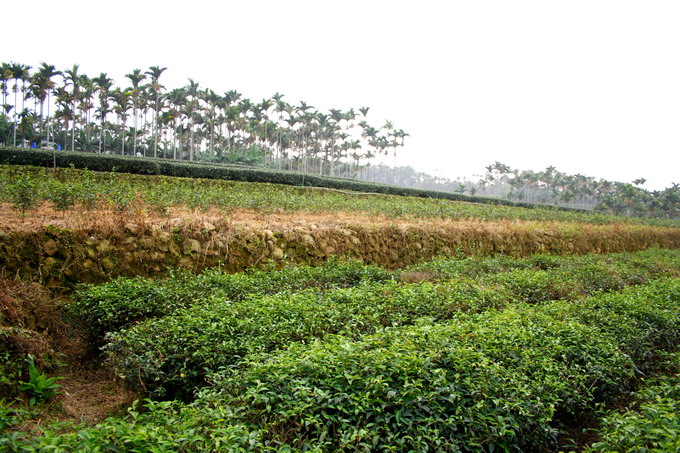
In Taiwan, majority of Dong Ding Oolong is produced not at Dong Ding Mountain, but everywhere. But we only obtain our Dong Ding Oolong tea that is produced only at Dong Ding Mountain. In addition, we select the winter tea that is known as the best high mountain tea.
How many times can we brew from 5g of tea leaves? It is all depends on the size of the tea pot and how you brew. However, we can believe that no matter how you brew, you can get nearly 1 liter of tea from 1 tablespoon of tea leaf.
Tea is baked with charcoal fire. It gives very confortable nutty aroma. Thanks to very thick aroma, it is suitable with oily meal such as Chinese cuisin and even with curry.
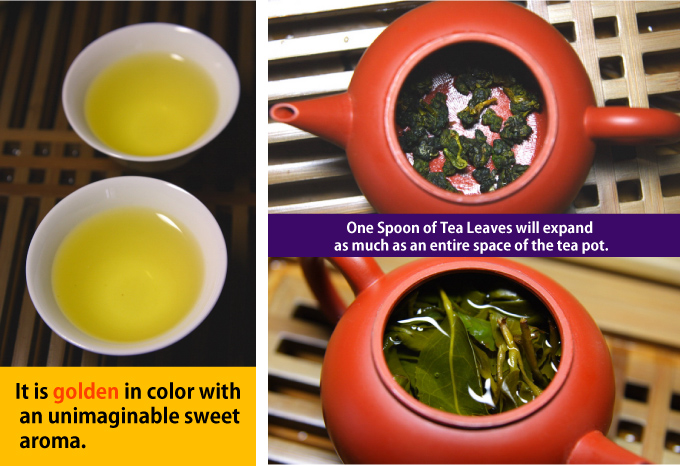
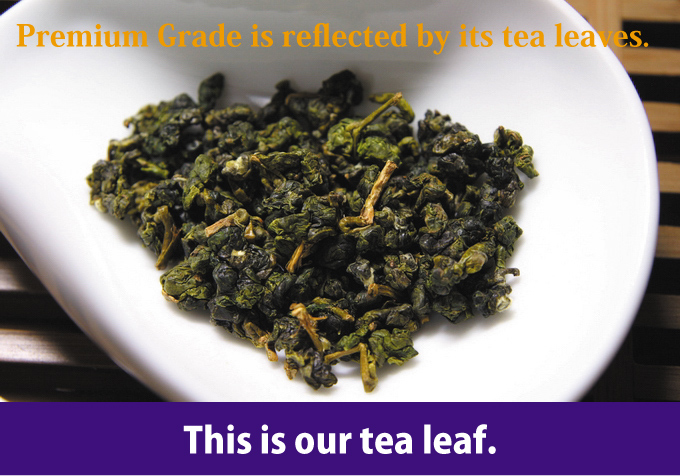
 Dong Ding Oolong is named after the mountain where the tea garden is located. The name of mountain is called Dong Ding Mountain. It is not very high mountain. The altitude of Dong Ding Mountain is at around 800m at maximum, yet it is producing reputable quality all the while. The reason we think why Dong Ding oolong is different from other mountain tea is that:
Dong Ding Oolong is named after the mountain where the tea garden is located. The name of mountain is called Dong Ding Mountain. It is not very high mountain. The altitude of Dong Ding Mountain is at around 800m at maximum, yet it is producing reputable quality all the while. The reason we think why Dong Ding oolong is different from other mountain tea is that:
1. The age of tea planted at Dong Ding Mountain is relatively old. Tea was planted at Dong Ding Mountain in a beginning state when tea was brought from Fujian, China. The old tree has longer root that absorb more mineral which makes tea stronger in flavor.
2. The Dong Ding mountain is has very windy and dry weather. Due to the hush weather in the environment, tea tree grows slower and therefore organic and inorganic substance is accumulated.
3. Dong Ding mountain consist of very rocky soil. It is very poor in organic nutrition but rich in mineral. Tea tree grows slower, yet it absorb mineral very effectively.
Recently the majority of Dong Ding oolong in Taiwan is not produced at Dong Ding Mountain. The number of tea garden at Dong Ding Mountain is very limited. Dong Ding mountain itself can not support increasing demand of Dong Ding oolong. In addition, there are many factors that differ the quality of Dong Ding oolong as follow.
a: From Dong Ding mountain
b: From other mountain
In general, higher the altitude the tea is produced, the better the quality it becomes. More volume of Dong Ding oolong is produced at lower altitude as the number of tea garden located at lower elevation is more.
Regardless of winter tea or spring tea, the best quality is made of the first plucked leaf. The second plucked leaf carries less mineral that gives weaker in flavor.
In general, there are 2 kinds of cultivars. Qing-Xin Oolong (青心烏龍種) and Jing Xuan Oolong (金萱烏龍種)Qing-Xin Oolong is classical type that gives refreshing flowery flavor, while Jing Xuan was developed recently by the tea research institute. It gives milky flavor.
Dong Ding oolong is divided into 2 types in terms of process. Classical Dong Ding oolong was baked with fire in order to bring up nutty aroma. It is loved by elder people or gentlemen while non-fired Dong Ding oolong gives flowery refreshing flavor that is loved by young people or lady in general.
Our Deep Fired Dong Ding Oolong is made from Qing-Xing cultivar that is grown at Dong Ding mountain at 800m. It is plucked earliest in the season and baked with medium strength of fire.
Dong Ding is the name of the mountain which is located in the center of Taiwan called Nantou. The name of Dong Ding derived from a story: the path to the peak of this mountain used to be very slippery and climbers needed to conserve their strength on their toes to hike this mountain; in Chinese that is called "Dong Jiao Jian" (凍脚尖) and thus derives the origin of the name Dong Ding.
About 150 years ago, the oolong cultivar was brought to Dong Ding Mountain from Wuyi, Fujian, China. Initially, the name of Dong Ding Oolong meant for the tea produced around Dong Ding Mountain. But when its fame and demand increased, ooong teas produced in other areas as well were also called Dong Ding Oolong as long as they followed the Dong Ding traditional manufacturing process. Nowadays there are some tea cultivators who even roast low grade tea and export it as Dong Ding Oolong.
HOJO's Dong Ding Oolong is produced exactly at the Dong Ding Mountain. Unfortunately, this oolong tea, produced at Dong Ding Mountain is getting very rare nowadays on account to its increasing demand and reputation. Many tea cultivators try to produce it at a lower cost and in larger volume which is more than that produced at the tea garden at Dong Ding Mountain. It is rather difficult to find genuine Dong Ding Oolong that is from Dong Ding Mountain. In Taiwan, people also start recognizing that Dong Ding Oolong = Type of Tea.
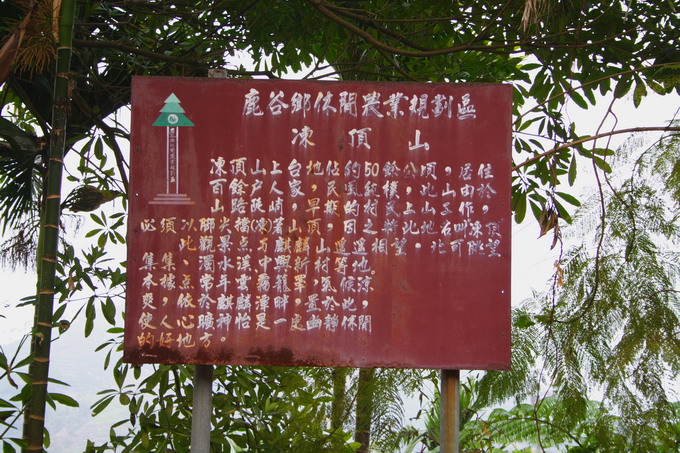

However we only want to introduce the genuine Dong Ding Oolong. Dong Ding Mountain is not only famous for its name, but also its environment and weather is suitable for high grade tea. The altitude of this mountain is not that high which is at around 1000m plus. The secret of Dong Ding Mountain is that it always produces identical quality due to its weather and soil condition. The tea garden gets very strong sunshine in the morning, but it is completely covered by fog in the afternoon. In addition, the environment is very windy, and the soil condition is less rich in nutrition. This severe environment causes the tea leaves to accumulate a lot of substances and leaving it no chance to consume these substances. That's the reason tea why tea produced at Dong Ding Mountain gives a very strong flavor and sweet after taste. You can easily recognize the difference once you've taste our tea.
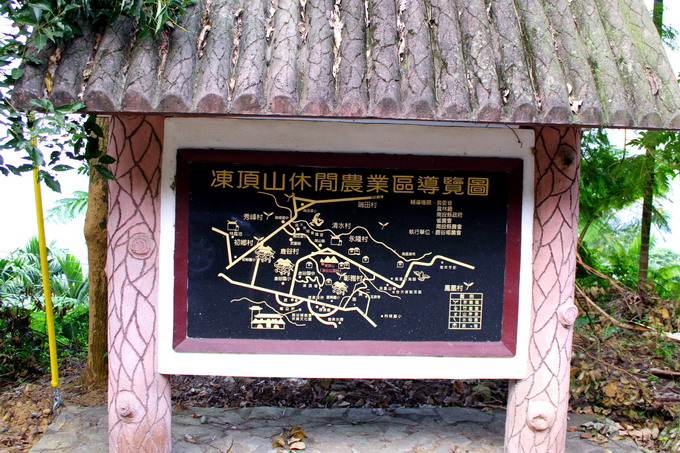
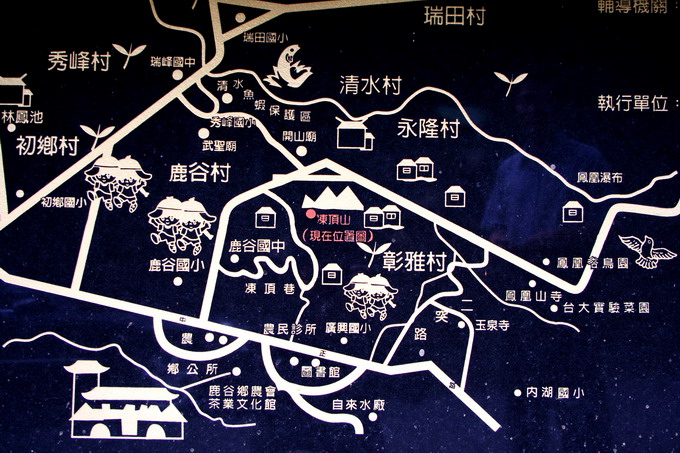
The sweet flavor and mellow taste is the identical characteristics of Dong Ding Oolong produced at Dong Ding Mountain. In addition, our Dong Ding Oolong is grown at a non-pesticide tea garden
|
Our Dong Ding Oolong is produced from Qing-Xin Oolong (青心烏龍種). This is the cultivars traditionally used for Dong Ding Oolong that gives a very refreshing taste. Tea grown at organic garden appears to be less active and less productivity as tea gets less nutrition and pesticide as compared to the ordinary tea garden. As the identical characteristics, tea leaf turns into yellow color and sweetness in flavor and taste is outstanding. Plucking is carried out by hand. 3 to 4 leaves including a bud is carefully plucked by hand. Plucking is carried out in Spring, Summer, Autumn and Winter. The best quality is produced either from Spring or Winter. |
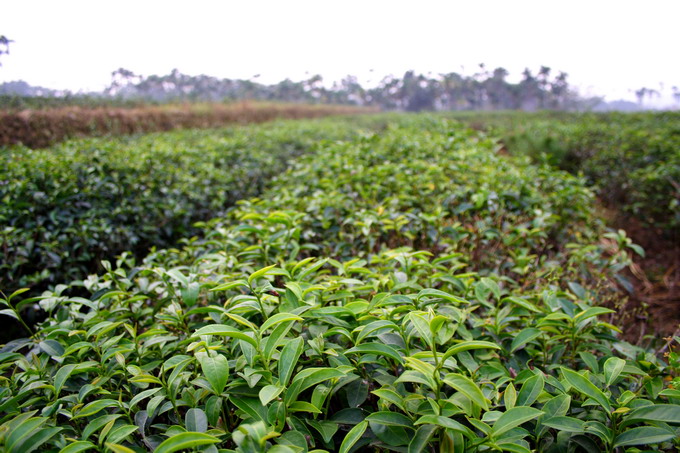
|
After plucking, tea leaves are spread over the ground under the natural sunshine. It is called Sunshine Withering. Usually clouded weather is ideal to grow this tea in order to avoid excess damage on tea leaves. If the sunny weather continues, a black cloth is used to cover the tea leaves to block out the harsh rays of sunshine. With sunshine withering, moisture inside the tea leaf gets evaporated and fermentation is moderately triggered. The tea leaf will gradually start releasing a refreshing aroma.
The method of fermentation for oolong tea is completely different from that of black tea. After the sunshine withering is completed, tea leaves are conveyed into the factory and spread over a sheet. If tea leaves are rich in moisture, they are spread into a thin layer in order to increase the evaporation process. The tea leaves are then tossed onto a bamboo tray. This agitation and tossing, causes friction which in turn causes the tea leaves to start fermentation. The tray is then placed on a rack and these processes are repeated over and over again. This is what is called fermentation. Tea leaves gets oxidation mediated by the oxidation enzyme when the tea leaves get bruised.
Once entering the fermentation room, you might get surprised with its fragrance. You feel as if you are in a flower garden. Subsequently tea leaves are rotated in a bamboo drum. The tea leaves are lifted and dropped several times. Gradually the edge of tea leaves get damaged and further fermentation takes place. Tea leaves are again spread over the bamboo tray and the same process is repeated over and over again.
Once tea leaves get sufficient fermentation, it starts generating a flowery fragrance. Tea that is processed by a fine tea master is easily distinguishable. The original shape is maintained without any damage done to the tea leaves and only the edge of tea leaves are found to be red in color. This indicates that the tea leaves were successfully semi-fermented and the quality is far different from the tea leaves which have a reddish appearance at the center part of the leaf. Once the tea master finds that fermentation is sufficiently achieved, the tea is then sent for heat treatment in order to arrest further fermentation process. If this is not carried out swiftly, the tea leaves will keep on fermenting and it will finally turn into black tea.
The number of rotation and timing of fermentation is judged based on the moisture content, flavor and color. This decision requires top-notch experienced tea technicians which affects the quality of tea tremendously. All technicians follow the instruction of a tea master. In order to get good quality tea, we need to pick out an excellent tea master.
At this stage, tea is fermented and giving an identical character of Dong Ding Oolong. However tea leave has not been damaged or bruised except for its edge. Without physical damage on tea leaf, it is difficult to "brew". On the other hand, conducting the rolling process as black tea that tea leaf is twisted tautly under the strong pressure, tea leaf will be over damaged and get astringent and harsh in taste. In addition, excessive damage of leaf will expose constituent to the oxygen and cause unwanted oxidation that will also affect to the taste and flavor. Therefore the very unique rolling process called "Bag rolling" is used for oolong tea. Literary tea leaf is wrapped in cloth and rolled. Therefore, tea leaves are twisted just right with the right amount of pressure applied.
While the tea leaves are still warm and soft, it is quickly wrapped in cloth bag. About 10-20kg of tea leaf is wrapped and it is made into the size of about a basket ball. Then the end of cloth is mechanically twisted by machine in order to squeeze it into a very solid ball. Finally it becomes as solid as a stone ball and as a result the tea leaves are compressed very tightly.
Then, the cloth ball is clamped between disks at the top and bottom. The top disk does not move while the bottom disk rotate and tea gets further pressure through the motion. After the rolling process is conducted for a while, the bag is opened and the tea leaves are taken out and reheated again in a rotating drum. This is necessary as once the tea leaves cool down, it becomes crispy and easily crushed. This series of processes are repeated several times until it is well rolled.
The tea leaves are gradually tighten and become round in shape. High grade tea is usually very solid and it appears to be dark and shiny as the juice of the tea leaf is squeezed and hardens on the surface of the leaf.
The same sequence is repeated over and over again. The parameter is varied depending on the condition of leaf such as moisture content. It is important to feel the condition of tea leaf and apply the suitable method of process which is judge expertly by the tea master.
After this rolling process is completed, the tea leaves are dried and this will reduce the moisture content down to 5%.
This is the specific process for traditional type of Dong Ding Oolong. Once the process of oolong tea is completed, it's sent to baking process. Baking process is carried out either conventional heater or charcoal fire. Baking means it is heated with indirect heat. It is different from "roasting". It sometimes misunderstood with roasting process of Chinese green tea. As for lower grade oolong, the roasting is carried out in stead.
Thanks to the baking process, tea creates very thick and nutty aroma. Relatively elder people and gentlment prefer this aroma, while young customer prefer non-fired Dong Ding Oolong.
Due to the baking process, there is some losses in about 20%. This is the reason that Dong Ding Oolong traditional type is always more expensive than non-fired Dong Ding Oolong.
Go to further information about suitable water for brewing tea >>
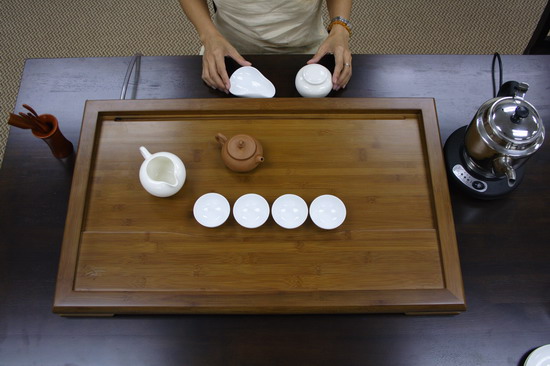
Arrange tea ware.
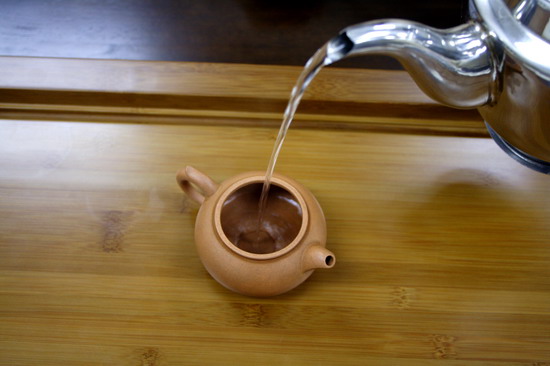
Pour boiling water into the tea pot and fill up. This is to heat up the tea pot. Without this process, the temperature of water reduce to 80 degree C, which is not sufficient to extract flavor.
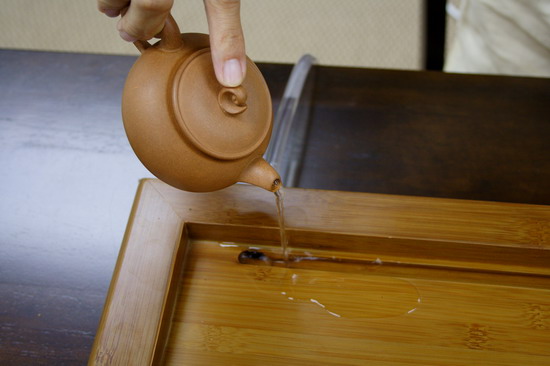
After 10 seconds, remove hot water from the warmed teapot.
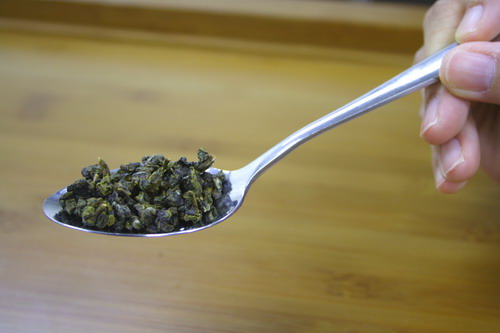
Usually 1g is equivalent to 25〜50ml of water.
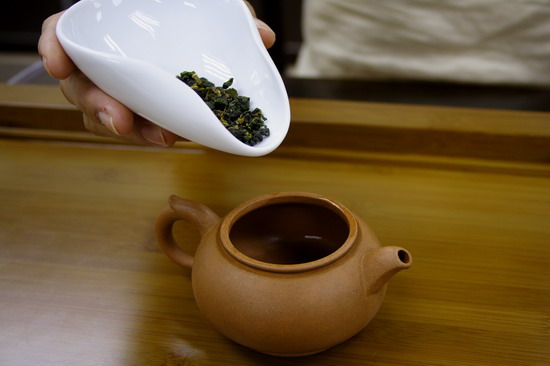
The teapot in the photo is about 200ml and therefore we take tea leaf around 5g.
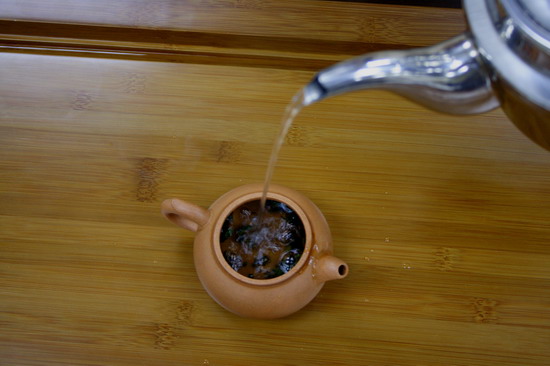
Pour boiling water onto tea leaf up to 70-80% of the volume of teapot. It is not for washing purpose, but to heat up the tea leaf.
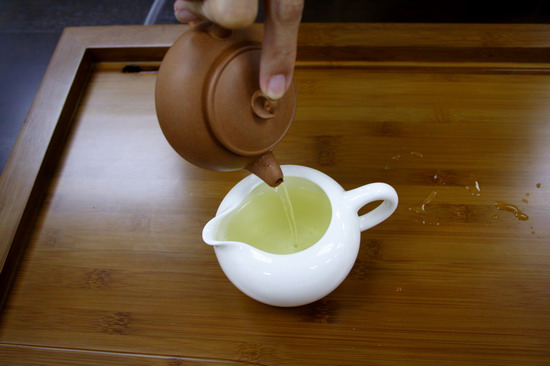
Once again pours off hot water within 10 seconds.
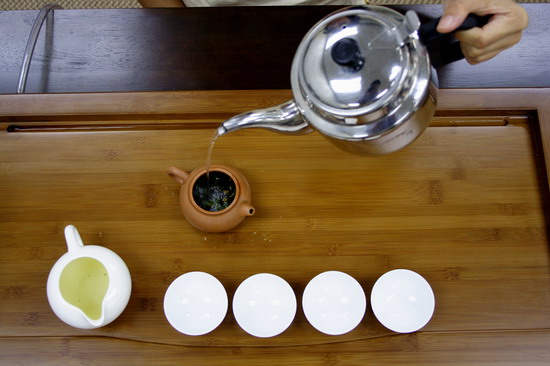
Pour boiling water again into teapot up to 90%.

Gently place the lid and leave it for 55 seconds. For second brewing leave it for 45 seconds, follow by 55 seconds for the third brewing.
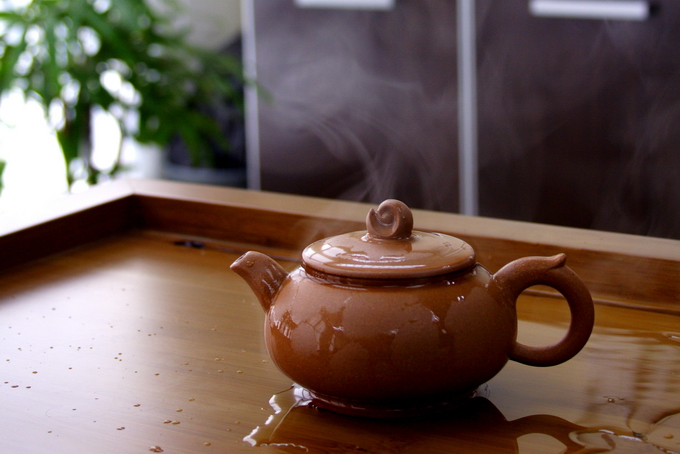
You can also pour boiling water over the cap in order to make sure that teapot is warm.
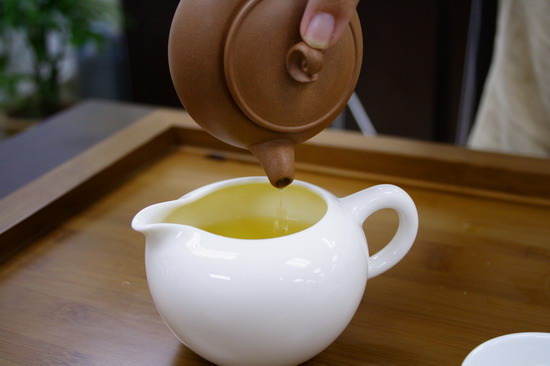
Pour tea into pitcher completely. It is important to enjoy the following brewing.
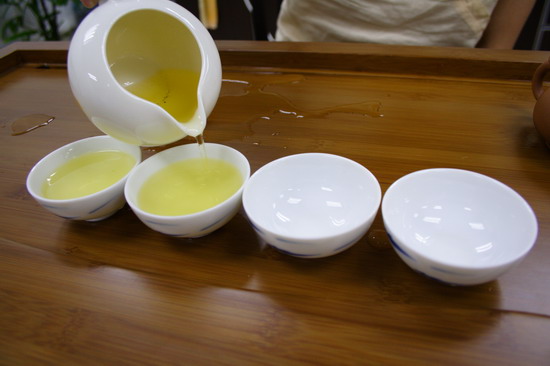
Pour tea from the right end which is supposed to be served for the guest. The last one is meant for the host.
Dong Ding Oolong is the tea that has taste and flavor which is well balanced. In addition, its has a very mellow and smooth taste thanks to its low tannin content. It is also suitable for those who worry about gastric. Thanks to the refreshing and flowery flavor, it also goes well with desert and not to mention best to serve during tea time when you want to enjoy a cup of tea.
Some people worry about the brewing method which is too traditional and complicated. However once you understand the theory, it is not so difficult. Most importantly, use very hot water and never reduce its temperature. The taste of green tea comes from the substance called theanine which is a kind of amino acid. This is the major component of sweet taste in green tea. As theanine is easy to be extracted at low temperature, brewing temperature for green tea is very low, while the taste of oolong tea is poly phenol which required very high temperature to be extracted.
Once a bag of tea is opened, please finish it within 3 months if you wish to enjoy its freshness. From the medical point of view, it is safe to consume the tea even if it is kept for a few years. However the freshness disappears if it is kept for too long. Tea must be tightly sealed before it is kept. Tea should be kept in ambient and dry conditions such as in the living room, but it must be completely away from humidity. Tea should not be kept in the kitchen as the environment is very humid. Avoid enclosed area such as inside the cupboard or drawer as these places are damp. Also avoid opening the bag of tea in humid atmosphere. It is recommended to open the bag during a sunny day or under air-conditioned atmosphere. Once tea leaves absorb moisture, deterioration of tea will be triggered within a few days. Tea will then give an astringent taste, sometime it tastes sour. The fresh aroma also becomes weaker.
The quality of tea lasts longer if it is kept in the fridge. However we strongly recommend you not to keep tea in the fridge. When tea is withdrawn from the fridge, there is usually condensation. Once tea is exposed to moisture during condensation, the quality will deteriorate within a few days. The higher moisture content in the tea leaves will trigger oxidation and it will completely destroy the quality of tea.
Here’s one frequently asked question: what happens if bag is sealed using tape or tea is packed in zipper bag and kept inside the fridge?
For your information, these simple sealing methods are not sufficient. When the bag is withdrawn from the fridge, it is cold inside the bag and therefore causes negative pressure. Air will be drawn from outside and condensation will occur. In addition, if the bag is taken in and out from the fridge very often, this will cause heat stress to the tea leaves as temperature is increased and decreased very frequently. If tea is kept in the fridge, when it is withdrawn from the fridge, it is necessary to leave it in ambient atmosphere for more than 24 hours in order to warm up the tea leaves. Based on our experience, 12 hours is not long enough. We may think tea is warmed up, but inside the bag, the tea leaves are still cold due to insulation effect.

Please feel free to send us e-mail for enquiry at:

 |
We accept various kinds of credit card through Paypal.
Only if customer prefer other option of payment, we suggest "Bank Transfer".
Various choice of shipping method
EMS, SAL, Small Packet, Small Packet (SAL) Yamato Express and Surface
For shipping tea, we usually suggest small air parcel, the estimated shipping cost of tea in 100g (with wrapping material ) is
Small Parcel
USA JPY 600, EU JPY600 and Asia JPY470
Small Packet (SAL)
USA JPY380, EU JPY380 and Asia JPY320
The shipping fee to oversea by small air parcel happens to be even cheaper than domestic shipping fee in Japan.
For your information, some countries, EU in particular imposes custom duty. We need buyer to bare the duty. We are sorry, but we cannot change the amount on the invoice, and we do not mark any packages as gifts. We will strictly follow the custom regulation.